Browse by Series/Collection
Group by: No Grouping | No Grouping Number of items: 10. Assessing the evidence of the impact of governance on development outcomes and poverty reductionThis paper synthesises academic and donor research on the impact of governance work on poverty reduction and development outcomes. There is a large body of work on the critical importance of good governance in developing countries which argues that good governance has both intrinsic and instrumental... [ more ] This paper synthesises academic and donor research on the impact of governance work on poverty reduction and development outcomes. There is a large body of work on the critical importance of good governance in developing countries which argues that good governance has both intrinsic and instrumental developmental value. Our introduction charts the historical emergence of ‘the good governance agenda’ from the early 1990s to the present day, through narrow technical understandings of governance reform, to the concept of ‘good enough governance’, and on to current wider emphases on political economy approaches to governance. The literature presents a mixed picture, showing that governance reforms have not always resulted in the expected improvements in development outcomes and poverty reduction. This is often argued to be because the success of governance reforms is often conditional on political factors. Other clear messages from the research are that bad governance impacts negatively on the poor and institutions matter for growth and poverty reduction. Policy implications from the research are that donors must take a long-term perspective as change to governance institutions takes place over long time horizons. Donors should also give more attention to the demand-side of governance, rather than focusing exclusively on top-down approaches to reform, as results have often been promising where citizens have been brought into governance interventions. | Author : Early, Lucy and Scott, Zoe Date : March 2010 Source : Technical Report. University of Birmingham, Birmingham, UK. Keywords : Governance, Development, Poverty Reduction Collection : GSDRC Emerging Issues Papers | ![[img]](/1517/1.hassmallThumbnailVersion/EarleScott_%2D2010%2D_GovernanceDevOutcomes.pdf) 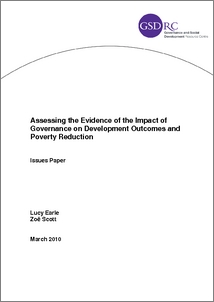 Preview |
|
| Community-based approaches to peacebuilding in conflict-affected and fragile contextsThe impact of violent conflict and fragility on a country’s society, economy and political governance is devastating and encompassing. The effects can be tangible and visible, including killed and injured civilians, destroyed or derelict bridges and wells, and damaged or inadequate health and educat... [ more ] The impact of violent conflict and fragility on a country’s society, economy and political governance is devastating and encompassing. The effects can be tangible and visible, including killed and injured civilians, destroyed or derelict bridges and wells, and damaged or inadequate health and education facilities. They can also be intangible, such as the collapse of state institutions, mistrust in government, the destruction of social relationships, psychological trauma and pervasive fear. Addressing both types of effects are essential in conflict-affected and fragile contexts. The ‘community’ has often proven to be resilient in such contexts, providing survival and coping mechanisms for insecurity and fragility. Experience has shown that even in areas of sheer desolation, social life and organisational systems can readily re-emerge within community networks. (Pouligny, 2005) Growing attention has thus been paid in recent years to the adoption of community-based approaches to help address the extensive needs in conflict-affected and fragile contexts. Fragile contexts are situations in which ‘state structures lack political will and/or capacity to provide the basic functions needed for poverty reduction, development and to safeguard the security and human rights of their population’. (OECD DAC, 2007) Conflict-affected contexts encompass situations prior to, during and after armed conflict. This paper explores the rationale behind community-based approaches; and key issues, challenges and considerations in designing and implementing such approaches. It highlights overarching issues across sectors and country-contexts, with particular focus on implications specific to conflict-affected and fragile contexts. Section one provides an overview of community-based approaches to peacebuilding, including a brief look at typology and community institutions. Section two outlines the key aims of community-based approaches and how these aims are approached. It also discusses the various challenges in fulfilling these aims and how these challenges can be addressed. Section three highlights key considerations in the planning, execution and monitoring of community-based approaches, including the set up of participatory, community institutions and funding mechanisms. Section four examines issues of sustainability. In particular, it discusses linking community processes to government in order to ensure greater impact and consolidation of community-based interventions. The final section provides an annotated bibliography of specific case studies and evaluations of community-based approaches, highlighting lessons learned and policy recommendations. | Author : Haider, Huma Date : November 2009 Source : Discussion Paper. University of Birmingham, Birmingham, UK. Keywords : peace-building, peacebuilding, state-building, statebuilding, community, community-based approaches, fragile states, conflict, development, international development Collection : GSDRC Emerging Issues Papers | ![[img]](/642/1.hassmallThumbnailVersion/EIRS8.pdf) 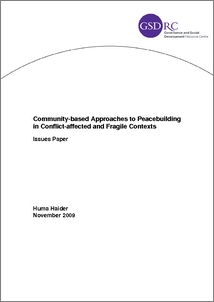 Preview |
|
| Increased Religiosity Among Women in Muslim Majority CountriesIt has hitherto been assumed, at least by western development practitioners, that women's rights are best attained through secularist liberal interpretations of equality, of the sort reflected in conventions such as the Convention on the Elimination of All Forms of Discrimination Against Women (CEDA... [ more ] It has hitherto been assumed, at least by western development practitioners, that women's rights are best attained through secularist liberal interpretations of equality, of the sort reflected in conventions such as the Convention on the Elimination of All Forms of Discrimination Against Women (CEDAW). Yet what does increasing use of the veil and greater religious observances across the Islamic world signify in this context? Does it reflect a rejection of these standards? And if understanding this move to greater religiosity requires a different paradigm of rights then how does this 'Islamic' paradigm sit with the 'western' one? This report argues that it is no longer possible to explain either women's various dress codes, nor their wider interest in understanding Islam, in terms of patriarchal norms and values because a large number of educated women are choosing to veil, immerse themselves in religious study and find other ways to be 'a true Muslim'. The social, political and economic contexts within which women live in muslim majority countries (MMCs) are in a constant process of change. Their increased literacy, access to information and communication technologies, as well as to wage-earning work, and their appropriation of religious knowledge from previously closed, male-dominated circles means that Muslim women are constructing their own modernity. This symbolises a break from many traditional practices as well as from Western conceptions of progress and equality. The issues paper argues that it is important for development policy makers and practitioners to take an interest in this upsurge in religiosity because it raises questions that are relevant to three key areas of their work: women's rights and gender equality; women as political actors (including in Islamist parties); and women's involvement in civil society (including religious movements). The annotated bibliography is written for those who want a more in-depth understanding of the issues introduced in the main paper; it nuances the debates around particular topics and includes more country examples. The key findings of the main report and the annotated bibliography are below. On gender equality: * The secularist approach to gender equality does exist within MMCs. However, it does not necessarily have wide appeal in MMCs; it is often seen as a foreign imposition; * Women throughout the Islamic world want social justice for themselves and others; the majority fervently believe that Islam can deliver this; * It is often difficult for women to unite as a political lobby for women's rights in MMCs; due to major divisions between a) those that believe that patriarchal and cultural interpretations of Islamic texts must be revisited and reinterpreted, and b) those that believe that these interpretations imply women are different not inferior so religious texts are not in need of reinterpretation. * The greatly increased propensity of women to veil today is a new phenomenon; its significance must be understood in terms of their Muslim identity but also their aspirations as modern women who want to work and travel safely, and be treated with respect not approbation. On Islamist parties: * Islamist parties are evolving their democratic credentials and their positions on women. They have moved from a 'purdah' position to one that supports women as economic and political actors. But they are dragging their feet on women's personal and family rights - the power base of the religious establishment; * Islamist parties are out for votes; women are a critical constituency; evolving policies in line with what the majority of ordinary women feel comfortable with (Muslim identity plus social justice) makes electoral sense. Having entered the democratic process Islamist parties have an incentive to come over as politically and socially 'moderate', not as hard liners; * For donors: understanding the internal dynamics of Islamist parties is important as they may form future governments. Understanding their stand on gender issues is also critical. Donors can give non-interfering support (e.g. supporting opportunities for Islamist and non-Islamist women to build alliances; funding projects that interpret religious texts in ways that uphold women's rights; supporting women's struggles to become elected political representatives). On religious civil society: * Millions of women in MMCs now attend religious study circles. This is a new experience for most women - in previous generations women had very little access to religious training; * Study circles need to be seen first and foremost as a piety movement; their adherents' main purpose is to get beyond formulaic manifestations of Islam and let religion guide their everyday actions and thoughts; but it is important to note that they do not encourage women to critique patriarchal readings of the texts; * There is little evidence to suggest study circles are politicised - although they may provide a link to Islamist parties in the longer term; * Religious instruction through study circles can be enormously empowering for women in a personal and familial sense rather than a political one. They give women an alternative means of gaining respect and authority within their households and immediate communities - an empowerment route most have not had before. | Author : Ladbury, Sarah and Khan, Seema Date : November 2008 Source : Technical Report. University of Birmingham, Birmingham, UK. Keywords : religion, international development, islam, gender, women, women's issues Collection : GSDRC Emerging Issues Papers | ![[img]](/648/1.hassmallThumbnailVersion/EIRS1.pdf)  Preview |
|
| Literature review on the dynamics of social movements in fragile and conflict-affected statesThis literature review assesses the available academic and policy-oriented literature on social movements in fragile and conflict-affected contexts. It examines who becomes involved in collective action and why, the barriers to mobilisation and, where social movements do emerge, how these are able t... [ more ] This literature review assesses the available academic and policy-oriented literature on social movements in fragile and conflict-affected contexts. It examines who becomes involved in collective action and why, the barriers to mobilisation and, where social movements do emerge, how these are able to sustain mobilisation and broaden their membership base to reflect the interests of the wider community. Evidence from this review suggests the importance of considering the interplay of movement activity and state stability, and of taking into account existing state-society relationships. Donors could focus on creating a supportive environment for social movements. | Author : Earle, Lucy Date : August 2011 Source : Technical Report. University of Birmingham, Birmingham, UK. Keywords : Social Movements, Fragile States, Conflict, Development Collection : GSDRC Emerging Issues Papers | ![[img]](/1514/1.hassmallThumbnailVersion/Earle_%2D2011%2D_dynamicsofsocialmovements.pdf) 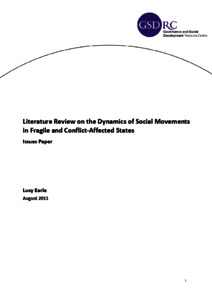 Preview |
|
| Political Settlements: Issues paperWhy do similar sets of formal institutions often have such divergent outcomes? An analysis of political settlements goes some way to answering this question by bringing into focus the contending interests that exist within any state, which constrain and facilitate institutional and developmental cha... [ more ] Why do similar sets of formal institutions often have such divergent outcomes? An analysis of political settlements goes some way to answering this question by bringing into focus the contending interests that exist within any state, which constrain and facilitate institutional and developmental change. It provides a framework to analyse how the state is linked to society and what lies behind the formal representation of politics in a state. The political settlement and the elite bargains from which it emerges are central to patterns of state fragility and resilience. The role of political organisation within the political settlement is crucial to both the stability of the settlement and the direction in which it evolves over time. The elite bargains that may lead to the establishment of what might be considered a resilient political settlement may also act as a barrier to progressive developmental change. Analysis of political settlements suggests that state-building is far from a set of technical formulas, but is a highly political process. Creating capacity within a state to consolidate and expand taxation is fundamentally determined by the shape of the political settlement underlying the state. This is true as well for the development of service delivery or any other function of the state. This analytical framework provides a window for donors to grasp the politics of a place in order to design more effective interventions. | Author : Di John, Jonathan and Putzel, James Date : June 2009 Source : Discussion Paper. University of Birmingham, Birmingham, UK. Keywords : politics, political settlement, social contract, international development, political economy Collection : GSDRC Emerging Issues Papers | ![[img]](/645/1.hassmallThumbnailVersion/EIRS7.pdf) 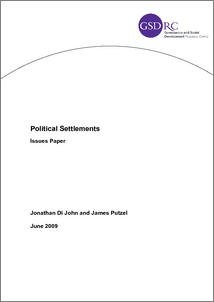 Preview |
|
| Political and social analysis for development policy and practice - an overview of five approachesThe use of Political Economy Analysis in development is a relatively recent phenomenon, beginning in the early 2000s. Prior to this, theory and practice largely ignored political and social context. Policies and programmes were planned and implemented in a technical manner, based on the presumption ... [ more ] The use of Political Economy Analysis in development is a relatively recent phenomenon, beginning in the early 2000s. Prior to this, theory and practice largely ignored political and social context. Policies and programmes were planned and implemented in a technical manner, based on the presumption that expertise and aid was sufficient to generate growth. The failure of development interventions to produce expected results led to a growing awareness among donors that politics, ‘political will’ and local context matter to development. In order to gain a better understanding of these issues, donors have developed various tools for political and social analysis. This paper provides a detailed overview of five of these tools and frameworks: Power Analysis, Drivers of Change, Strategic Corruption and Governance Analysis, Poverty and Social Impact Analysis, and Problem-Driven Political Economy Analysis. Under each tool or framework, it discusses how to use the tool (research methods, processes, outputs, and elements of the approach); skills and resources required; the value added and operational impact of the approaches; key challenges; and linkages with other analytical tools. | Author : Haider, Huma and Rao, Sumedh Date : September 2010 Source : Technical Report. University of Birmingham, Birmingham, UK. Keywords : Political Economy Analysis, Development, Policy Collection : GSDRC Emerging Issues Papers | ![[img]](/1516/1.hassmallThumbnailVersion/HaiderRao_%2D2010%2D_PoliticalSocialAnalysis.pdf)  Preview |
|
| Quantitative and Qualitative Methods in Impact Evaluation and Measuring ResultsThere has been a renewed interest in impact evaluation and measuring results in recent years amongst development agencies and donors. This paper reviews the case for promoting and formalising qualitative and combined methods for impact evaluation and measuring results, as part of a broader strategy ... [ more ] There has been a renewed interest in impact evaluation and measuring results in recent years amongst development agencies and donors. This paper reviews the case for promoting and formalising qualitative and combined methods for impact evaluation and measuring results, as part of a broader strategy amongst donors and country partners for tackling the evaluation gap. The accompanying workshop report provides a summary of the January 2009 workshop “Make an Impact: Tackling the “I” and the “D” of Making It Happen”, which aimed to familiarise DFID staff with the use of qualitative methods in impact evaluation and measuring results. The case for qualitative and combined methods is strong. Qualitative methods have an equal footing in evaluation of development impacts and can generate sophisticated, robust and timely data and analysis. Combining qualitative research with quantitative instruments that have greater breadth of coverage and generalisability can result in better evaluations that make the most of their respective comparative advantages. | Author : Garbarino, Sabine and Holland, Jeremy Date : March 2009 Source : Discussion Paper. University of Birmingham, Birmingham, UK. Keywords : monitoring, evaluation, accountability, impact evaluation, qualitative methods, quantitative methods Collection : GSDRC Emerging Issues Papers | ![[img]](/646/1.hassmallThumbnailVersion/eirs4.pdf) 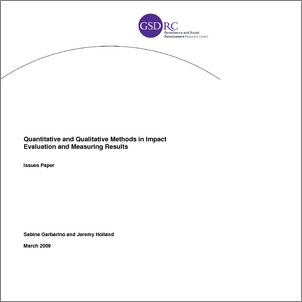 Preview |
|
| Southern perspectives on technical cooperation - analytical review and annotated bibliographyThis paper is divided into two parts. Part A is an Analytical Review which synthesises findings on Southern perspectives from the post-2000 literature on technical cooperation (TC). Part B is an Annotated Bibliography which provides reference details, internet links and summaries of the key resource... [ more ] This paper is divided into two parts. Part A is an Analytical Review which synthesises findings on Southern perspectives from the post-2000 literature on technical cooperation (TC). Part B is an Annotated Bibliography which provides reference details, internet links and summaries of the key resources on this topic. The review identifies several areas of concern to Southern nationals and recipient governments. There are a few that stand out as key, either because of the frequency with which they are mentioned, or because of the depth of criticism they have evoked. A series of policy recommendations are supplied based on key findings. | Author : Scott, Zoe Date : 2009 Source : Discussion Paper. University of Birmingham, Birmingham, UK. Keywords : Technical Co-operation, Development Collection : GSDRC Emerging Issues Papers | ![[img]](/1520/1.hassmallThumbnailVersion/Scott_%2D2009%2D_SouthernPerspectives.pdf) 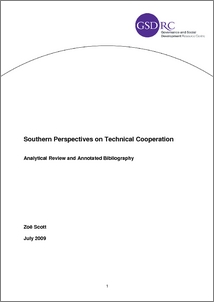 Preview |
|
| State Capacity and Non-state Service Provision in Fragile and Conflict-affected StatesHow can governments effectively engage with non-state providers (NSPs) of basic services where capacity is weak? This paper examines whether and how fragile and conflict affected states can co-ordinate, finance, and set and apply standards for the provision of basic services by NSPs. It explores way... [ more ] How can governments effectively engage with non-state providers (NSPs) of basic services where capacity is weak? This paper examines whether and how fragile and conflict affected states can co-ordinate, finance, and set and apply standards for the provision of basic services by NSPs. It explores ways of incrementally engaging the state, beginning with activities that are least likely to do harm to non-state provision. Through the ‘indirect’ roles of setting the policy environment and engaging in policy dialogue, regulating and facilitating, contracting, and entering into mutual and informal agreements with NSPs, the state can in principle assume responsibility for the provision of basic services without necessarily being involved in direct provision. But government capacity to perform these roles is constrained by the state’s weak legitimacy, coverage and competence, lack of basic information about the non-state sector, and lack of basic organisational capacity to form and maintain relationships with NSPs. The experience of the exercise of the indirect roles in fragile settings suggests: * Governments may be more willing to engage with NSPs where there is recognition that government cannot alone deliver all services, where public and private services are not in competition, and where there is evidence that successful collaboration is possible (demonstrated through small-scale pilots). * The extent to which engagements are ‘pro-service’may be influenced by government motives for engagement and the extent to which the providers that are most important to poor people are engaged. * Formal policy dialogue between government and NSPs may be imperfect, unrepresentative and at times unhelpful in fragile settings. Informal dialogue - at the operational level - could more likely be where synergies can be found. * Regulation is more likely to be ‘pro-service’ where it offers incentives for compliance, and where it focuses on standards in terms of outputs and outcomes rather than inputs and entry controls. * Wide scale, performance-based contracting has been successful in delivering services in some cases, but the sustainability of this approach is often questioned. Some successful contractual agreements have a strong informal, relational element and grow out of earlier informal connections. * Informal and mutual agreements can avoid the capacity problems and tensions implicit in formal contracting but may present problems of non-transparency and exclusion of competition. Paradoxically, the need for large-scale approaches and quick co-ordination of services in fragile and conflict-affected settings may require ‘prematurely high’ levels of state-NSP engagement, before the development of the underlying institutional structures that would support them. When considering strategies to support the capacity of government to engagement with NSPs, donors should: * Recognise non-state service provision and adopt the ‘do no harm’ principle: It would be wrong to set the ambition of 'managing ‘ non-state provision in its entirety, and it can be very harmful for low-capacity states to seek to regulate all NSP or to draw it into clumsy contracts. * Beware of generalisation: Non-state provision takes many forms in response to different histories and to political and economic change. The possibilities and case for state engagement have to be assessed not assumed. The particular identities of NGOs and enterprises should be considered. * Recognise that state building can occur through any of the types of engagement with NSPs: Types of engagement should therefore be selected on the basis of their likely effectiveness in improving service delivery. * Begin with less risky/small scale forms of engagement where possible: State interventions that imply a direct controlling role for the state and which impose obligations on NSPs (i.e. contracting and regulation) require greater capacity (on both sides) and present greater risk of harm if performed badly than the roles of policy dialogue and entering into mutual agreements. * Adopt mixed approaches: The choice between forms of engagement does not have to be absolute. Rather than adopting a uniform plan of engagement in a particular country, it may be better to try different approaches in different regions or sectors. | Author : Batley, Richard and Mcloughlin, Claire Date : February 2009 Source : Technical Report. University of Birmingham, Birmingham, UK. Keywords : international development, services, health, education, sanitation, fragile states Collection : GSDRC Emerging Issues Papers | ![[img]](/647/1.hassmallThumbnailVersion/EIRS3.pdf) 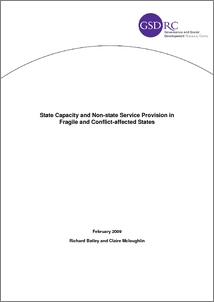 Preview |
|
| The impact of the financial crisis on conflict and state fragility in Sub-Saharan AfricaThe global financial crisis was triggered by the bursting of the United States housing bubble in 2007 and the reverberations of this are now being felt throughout the world. The crisis was greatly exacerbated by the behaviour of banks, which has inevitably made the position of any country that has b... [ more ] The global financial crisis was triggered by the bursting of the United States housing bubble in 2007 and the reverberations of this are now being felt throughout the world. The crisis was greatly exacerbated by the behaviour of banks, which has inevitably made the position of any country that has borrowed money worse off. Sub-Saharan Africa was largely insulated from the initial stages of the financial crisis as the majority of the countries in the region are de-linked from the international financial markets. However, with the worsening of the global financial and economic crisis, the region as a whole has now been exposed to the downturn, and growth estimates have been continually lowered from 5 percent in 2008 to 1.7 percent in April 2009 (IMF, 2009). Many Sub-Saharan African countries are dependent on foreign finance inflows and are even more dependent on commodity based export growth (Naudé, 2009). This has left them particularly exposed to shocks and World Bank economists are warning that although Africa is the least integrated region, it could actually be the worst hit (Devarajan, 2009a). Given that Africa is already the most conflict ridden continent in the world, an exacerbation of resource scarcity could increase conflict across the continent. Emerging markets (e.g. South Africa, Nigeria, Ghana and Kenya) were hit first through their stock exchanges and financial links with other regions in the world; but the crisis has now affected the region's lower income countries (LICs) through indirect channels and because they are reliant on the stronger regional economies for trade and remittances. In addition to financial shocks, Sub-Saharan Africa is also reeling from the food and fuel price shocks of 2007-08. Many countries in the region are already making unsatisfactory progress in their efforts to achieve the Millennium Development Goals; this “triple jeopardy” has thrown millions of households into poverty and will further hinder progress (World Bank, 2009). | Author : Bakrania, Shiv and Lucas, Brian Date : July 2009 Source : Discussion Paper. University of Birmingham, Birmingham, UK. Keywords : economic crisis, financial crisis, africa, sub-saharan africa, conflict, security Collection : GSDRC Emerging Issues Papers | ![[img]](/643/1.hassmallThumbnailVersion/EIRS6.pdf) 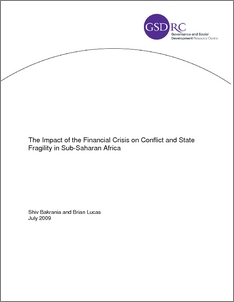 Preview |
|
|
This list was generated on Sat Nov 2 01:46:52 2024 GMT. |

